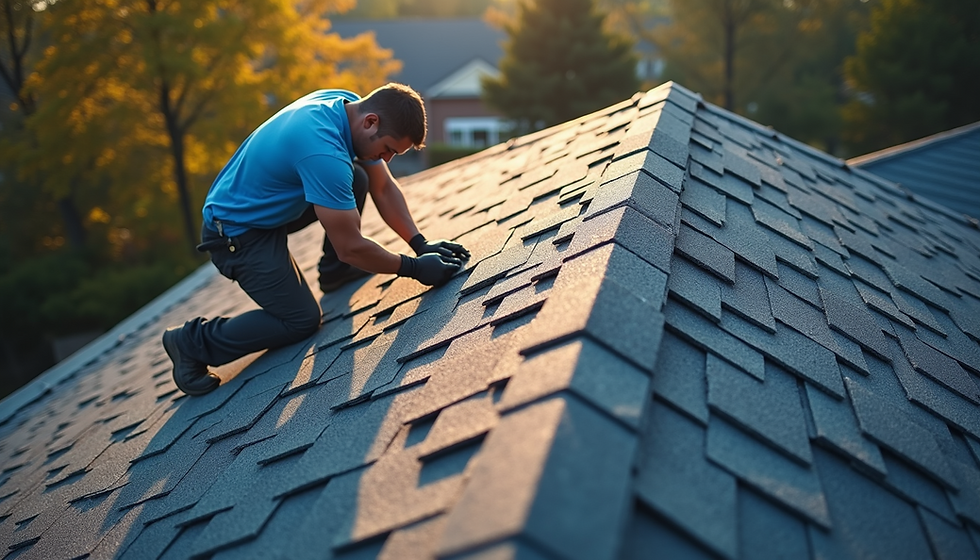Repairing Roofs: Proven Techniques for Success
- James Creed
- Aug 22
- 4 min read
Maintaining a sturdy roof is essential for protecting your home from the elements. Over time, roofs can develop leaks, cracks, or other damage that requires attention. Knowing how to identify problems early and apply effective repair methods can save you money and extend the life of your roof. This roof repair guide will walk you through practical techniques and considerations to help you tackle common roofing issues with confidence.
Understanding the Basics: Roof Repair Guide
Before diving into repairs, it’s important to understand the structure and materials of your roof. Most residential roofs are made from asphalt shingles, metal, tile, or wood. Each material requires specific repair methods.
Asphalt shingles: The most common roofing material, known for affordability and ease of repair.
Metal roofs: Durable but prone to dents and rust; repairs often involve patching and sealing.
Tile roofs: Fragile and heavy; broken tiles need replacement rather than patching.
Wood roofs: Require treatment against rot and insect damage.
Regular inspections can help you spot issues early. Look for missing shingles, curled edges, rust spots, or water stains inside your home. These signs indicate that your roof needs attention.

Essential Tools and Materials for Roof Repair
Having the right tools and materials on hand makes the repair process smoother and safer. Here’s a checklist of essentials:
Ladder: Ensure it is stable and tall enough to reach your roof safely.
Hammer and roofing nails: For securing shingles or tiles.
Roofing cement or sealant: Used to patch small holes or cracks.
Replacement shingles or tiles: Match the existing material for a seamless fix.
Utility knife: To cut shingles or roofing felt.
Pry bar: To remove damaged shingles or tiles.
Safety gear: Gloves, safety glasses, and non-slip shoes.
Before starting, check the weather forecast. Avoid repairs on rainy or windy days to reduce risk and ensure materials adhere properly.

How much should roof repair cost?
The cost of roof repair varies widely depending on the extent of damage, roof type, and local labor rates. Minor repairs like replacing a few shingles or sealing small leaks can cost between $150 and $400. More extensive repairs involving structural damage or large areas may run from $1,000 to $3,000 or more.
Factors influencing cost include:
Roof size and pitch: Steeper or larger roofs require more labor.
Material type: Tile and metal repairs tend to be pricier than asphalt.
Accessibility: Difficult-to-reach roofs increase labor time.
Extent of damage: Hidden damage under shingles can raise costs.
Always get multiple quotes from reputable contractors. For DIY repairs, factor in the cost of materials and safety equipment. Remember, investing in timely repairs can prevent costly replacements later.

Step-by-Step Techniques for Effective Roof Repair
Here are proven techniques to repair common roof problems:
Fixing Leaks
Locate the leak by inspecting the attic or roof surface.
Remove damaged shingles or tiles carefully.
Apply roofing cement or sealant to the affected area.
Replace shingles or tiles and secure them with nails.
Check for proper sealing around chimneys, vents, and flashing.
Replacing Missing or Damaged Shingles
Pry up the edges of surrounding shingles.
Slide out the damaged shingle.
Insert a new shingle and nail it in place.
Seal the edges with roofing cement to prevent wind damage.
Repairing Flashing
Inspect metal flashing around roof joints.
Remove rusted or loose flashing.
Install new flashing with roofing nails and seal edges with roofing cement.
Cleaning and Maintaining Gutters
Clear debris to prevent water backup.
Check for leaks or damage in gutters and downspouts.
Repair or replace damaged sections to ensure proper drainage.
Following these steps carefully will help you maintain a watertight and durable roof.
Tips for Preventing Future Roof Damage
Prevention is key to extending your roof’s lifespan. Here are some actionable tips:
Regular Inspections: Check your roof at least twice a year and after major storms.
Trim Overhanging Branches: Prevent branches from scraping or falling on your roof.
Clean Gutters: Avoid water pooling that can damage shingles and fascia.
Remove Moss and Algae: Use roof-safe cleaners to prevent moisture retention.
Ensure Proper Attic Ventilation: Reduces heat buildup that can warp roofing materials.
By staying proactive, you can avoid costly repairs and keep your roof in top condition.
When to Call a Professional
While many repairs can be done by homeowners, some situations require expert help:
Extensive water damage or leaks.
Structural damage to roof decking or supports.
Complex flashing or chimney repairs.
Roof replacement or large-scale repairs.
Safety concerns with steep or high roofs.
If you are unsure about the repair process or lack the proper equipment, hiring a professional ensures the job is done safely and correctly.
For reliable assistance, consider contacting specialists who can repair roof issues efficiently and affordably.
Taking care of your roof is an investment in your home’s safety and value. With the right knowledge and tools, you can handle many repairs yourself or know when to seek professional help. Use this roof repair guide as a resource to keep your roof strong and secure for years to come.




Comments